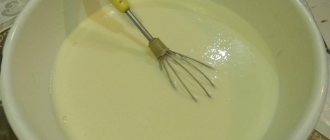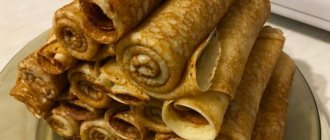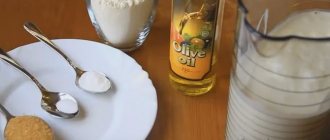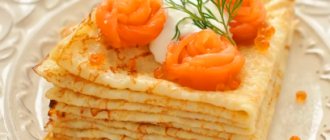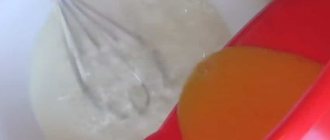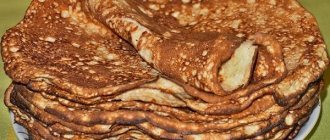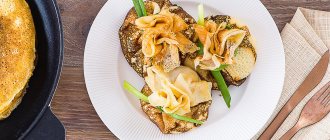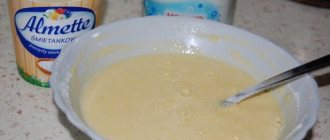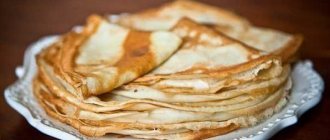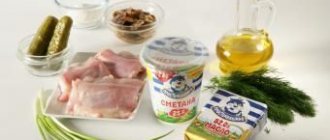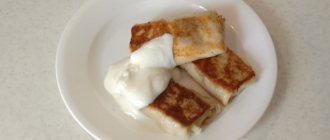There are many recipes for making pancakes. It doesn’t matter which one you prefer, any of them will have flour among the main ingredients. Don’t be lazy to sift it: this way you will not only clear it of lumps and impurities, but also saturate it with air. With this flour the dough becomes light and fluffy.
For the best pancake mix, it is advisable for the milk and eggs to be at room temperature. They should be taken out of the refrigerator in advance or warmed a little before use. Ideally, it is better to beat the yolks and whites separately. Proteins, brought to a fluffy foam, must be added at the very end to make the dough lacy. Flour is introduced gradually and carefully, constantly stirring the dough. But this should be done after you have thoroughly mixed the liquid ingredients.
Don't forget to add at least a pinch of salt to the dough, even if you are planning dessert pancakes. Salt gives the dish an interesting and rich taste. Another important touch is a little sunflower oil: with it the dough will stick to the pan less, and you will have to grease it less often. A sign of a good freshly kneaded dough is small bubbles on its surface. Over time they disappear.
What consistency should the dough be?
The golden mean is important here: the dough should not be too thick or too thin. Its ideal consistency is a bit like liquid sour cream or heavy cream. The dough should not spread in the pan too quickly or too slowly. In the first case, you need to add a little more flour to it, and in the second, dilute it with warm water: it improves not only the consistency of the dough, but also has a positive effect on the taste and fluffiness of the pancakes.
Thin pancakes in a frying pan: cooking secrets
Secret No. 3: choosing a frying pan
New kitchen utensils are appearing to make cooking easier. And our grandmothers still use old cast-iron frying pans, on which they bake the thinnest lacy pancakes for their grandchildren without any problems. You can use others, but a good frying pan for thin pancakes has certain rules:
- the bottom should be thick so that it heats up evenly and retains heat well;
- Before frying, the pan must be warmed up, otherwise it will not be possible to turn the pancakes over; they will stick;
- Be sure to lubricate the bottom with sunflower oil or fat; you can add oil to the dough.
Our wise grandmothers always had a separate frying pan for pancakes. Nothing else was supposed to be fried in it, and washing it was allowed only on holidays. After baking, it was thoroughly wiped with a napkin, which removed the fat.
Secret No. 4: correct dough consistency
There are a huge number of recipes for making thin pancakes. The dough for them can be prepared with the addition of various liquid ingredients:
- milk;
- water (sometimes boiling water);
- kefir;
- mineral water;
- fermented baked milk;
- curdled milk.
There is an unspoken proven rule that the thinnest pancakes are made with milk or water. Other products add fluffiness. Under no circumstances should yeast, any baking powder or soda be added. How can you be thin if the dough is moving?
To prevent lumps from appearing in the dough, you must first mix the dry ingredients. Gradually wet products are added to them. Everything is mixed very thoroughly. It is more convenient to use a blender rather than a spoon: time is saved and the result is much better. Additionally, the dough is once again saturated with oxygen when it is mixed quickly.
The consistency of the pancake dough resembles thin cream. It flows easily from a spoon and fits perfectly on any surface. If you were unable to get the desired consistency the first time, you can correct the situation:
- If the dough is too thick, dilute it with a small amount of water or milk.
- The rare dough will have to be thickened with flour. To prevent lumps from forming, part of the finished mass is poured into a bowl, flour is poured into it, everything is mixed and added to the main composition.
Secret #5: eggs for bonding
Eggs will never fail. They can strengthen even the most fragile batter. First, it is advisable to add one egg and try to bake the first pancake. If it turns out to be far from ideal, you can add one or a couple more (depending on the amount of dough). There is no need to immediately add them to other products. It is better to beat with a whisk or mixer. When the mass is filled with air, it is poured into the batter.
How and with what to grease a frying pan?
Suitable lubricants for frying pancakes are: vegetable, butter or ghee, lard or any animal fat. To ensure that the surface of the pan is evenly greased, you can use half an onion or a raw potato placed on a fork. Our grandmothers also used this “brush”. You can replace it with a regular silicone culinary brush. You need to grease not only the bottom of the pan with oil, but also its entire inner surface.
Why do pancakes turn out brittle?
Due to improper baking on the stove and pan
It is best to fry pancakes in the same frying pan, preferably cast iron - its thick bottom holds the temperature better, heats up more and cooks pancakes and pancakes more evenly.
The stove can be electric or gas, the main thing is that the heat is strong enough. If the oven is at minimum power or the lowest heat, the pancake will simply dry out, while remaining pale and unappetizing.
We recommend articles on the topic and pancakes will never turn out dry and brittle.
- Which frying pan should you use to bake pancakes?
- What fire to cook pancakes on
The brittleness of the dough is most often associated with incorrectly selected baking temperature. The first raw side should take no more than one and a half to two minutes of frying. This time is enough for browning.
Fry the second side even less - half a minute or a minute. The balance between the fact that the pancake is baked, but not too dry, is the key to a delicious delicacy!
Regularly greasing the pan
Regular greasing of the pan also helps prevent dry pancakes. Not everyone likes to fry in oil, preferring a dry frying pan, but this method works. The pancakes turn out more juicy, rosy and soft.
How to grease a pan for baking pancakes
They are easy to fold into quarters immediately after baking. Apply oil to the pan every 2-3 pancakes.
If you want to grease it with butter, melt it and pour a teaspoon over the pancake along the outer edge to cover the driest places.
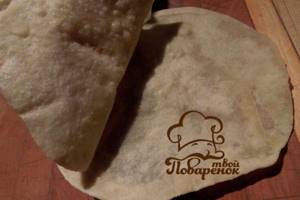
Improper storage
Like frying over low heat, improper storage can ruin the most delicious dough. Improper storage will also cause the edges of the pancakes to become dry.
It is best to keep ready-made pancakes under a lid, and they should not be covered in the entire stack after the last one is ready, but continuously during baking.
That is, we lift the lid only to add another pancake to the stack. This is one of the most reliable ways to soften even dry dough in water.
The pancakes will not become soggy; on the contrary, under the influence of temperature and humidity they will infuse and become really tasty.
Now you know why pancakes turn out dry and brittle, and you can avoid this by using a few culinary tricks. Try to apply them, and the result will not disappoint you; on the contrary, both you and your household will be pleasantly surprised!
How much and how to pour the dough?
The thickness and taste of the pancakes depends on the amount of dough in the pan. The capacity of the ladle needs to be measured against the size of the frying pan and the ideal ratio must be found. For example, for a medium-sized frying pan (with a bottom diameter of 20 centimeters), one standard ladle (about 0.14 milliliters) of dough will be quite enough. There are two best known ways of pouring dough: into the middle of the dish and from one of the raised sides. In any case, it is necessary to achieve uniform distribution of the dough over the bottom of the pan. To do this, you need to quickly and carefully pour the dough, slightly tilting and rotating the bowl clockwise.
Test preparation
In fact, this is a rather difficult stage. The whole point is to mix the dough to the perfect consistency. The definition of this very ideal is very vague, but it is usually explained as “the thickness of sour cream.” To test it, take a spoonful of dough and see how quickly it flows. Even if it is not clear, very soon you will learn to determine the thickness of the test by eye.
This very density can be achieved in two ways. First, you must stir the dough very thoroughly so that not a single lump of flour remains. The mass should be homogeneous, one-color, moderately liquid. It’s very difficult to do this with a whisk or, especially, a spoon, so don’t pay attention to opponents of modern technology and use a mixer - this will guarantee that you won’t waste the dough.
The second method is the exact amount of ingredients. Try to follow the recipe exactly - those “unimportant” 10-20 grams can turn out to be critically important for the dish and the entire balance will be upset. You should not add more flour if you think the dough is too liquid - this will also ruin the final result.
In both cases, nothing good will happen to your pancakes. If there is not enough flour, there is a chance that the pancakes will not thicken at all in the pan, but will only dry out to it, eventually burning to the coating. Excess flour will make the pancakes too bulky - you can easily flip them, but they will burn rather than cook from the inside due to their thickness. This way you will either get a burnt pancake or a raw pancake.
How to heat a frying pan correctly?
The main reason for lumps in pancakes is an insufficiently heated frying pan. Please note that a cast iron frying pan takes longer to heat up than a regular Teflon frying pan. The size of the burner is selected according to the size of the frying pan. The smaller the burner, the stronger the flame should be, but do not bring it to maximum. The best option is a medium burner with medium heat intensity. On a wide burner there is a risk that the core of the pancake will not cook well. You can speed up the cooking process by using 2 or 3 pans at once.
Two video recipes for pancake dough from the chef of our website
Povarenok has many proven pancake recipes, which you can find in the video or on our website.
Happy cooking!
If there are people in the world who don’t like pancakes, it’s only because they’ve never tried them. What could be better than a stack of rosy, hot pancakes emanating with fragrant steam? And it’s all the more offensive for the hostess when her delicate, delicious masterpieces, even prepared according to all the rules, begin to tear. In fact, why do pancakes, into which so much love and care have been invested, tear? Is the frying pan not hot enough? Too thick? Wrong dough?
To prepare lacy thin pancakes, you need to know the secrets of their preparation
When and how to flip pancakes?
When frying pancakes, it is important not to dry them out. The condition that signals the pancake needs to be flipped is a smooth, bubbly, slightly golden surface with no remaining batter. There is no need to wait until the bottom of the cake turns chocolate brown. Although some people really like these crispy pancakes.
Before flipping the pancake, run a spatula along the edges, gently peeling them away from the surface of the pan. Then, sliding the spatula to the middle of the pancake, quickly turn it over. It is best to use a thin wooden spatula for these purposes. Metal utensils can damage the coating of the pan and tear the thin pancake circle.
Pancakes tear when frying or turning over - what to do?
So, the pancake is still torn - what to do in this situation?
You can prevent “spoilage” of the following pancakes by taking into account some recommendations:
- Pay attention to the surface of the coating. If it is Teflon, most likely the pancakes will tear when flipped. To correct the situation, add boiling water to the dough.
- Moderate the fire. Often pancakes tear from baking over high heat.
- Incorrect selection of the shoulder blade can also cause ruptures. The turning tool must be made of wood.
- Pancakes that tear are most likely missing eggs. You should add an egg to the dough and try to bake another pancake. It is important not to overdo it, because too much makes the pancakes tough.
- To eliminate such a situation, you should learn how to turn them over correctly. To do this, carefully move the spatula around the entire product, leave it in its central part, and only then turn it over.
How to transfer pancakes from a frying pan to a plate?
There are at least 3 ways to do this: using a wooden spatula, a fork and a masterly release with an accurate calculation of the trajectory of its flight onto the plate. The first option is the most convenient and simple: from an inclined frying pan, a pancake, held with a spatula, slowly slides onto a plate. The second method is more risky: using a fork can damage the pancake, but with its help you can easily find out about the degree of readiness of the dish. The third, effective option is difficult to implement without proper training and skills.
A trick from the mother-in-law: when the pancakes are torn, you need to add eggs
My mother-in-law told me one little trick. She said that when pancakes start to tear for unknown reasons, you definitely need to add a couple of fresh chicken eggs to the dough. By the way, this move saves the situation even if the base was spoiled by an excess of any ingredient.
It just got a little dry while you were frying a whole mountain of pancakes for Maslenitsa, and that’s why it breaks. Try wrapping hot pancakes and you are guaranteed success. Or perhaps you just made a very thick pancake batter, the water evaporated during the frying process and the pancake remained dry on the sides, where it breaks.
How to serve pancakes?
It is worth considering in advance the number of people you are going to treat with pancakes. On average, there are 3-4 pancakes per serving. But during Maslenitsa, 5 pancakes per guest “fly away”. On this holiday, pancakes can be served as a main course, and not just as a pastry for tea. A plate with a stack of pancakes, several bowls with sauces are placed in the center of the table, and guests are given personal plates with forks and teaspoons. And don't forget about napkins - there should be enough for everyone.
Kefir pancake recipes
Thin pancakes with kefir
Ingredients: flour – 300–350 g; kefir – 1 l; eggs – 4 pcs.; melted butter - 2 tbsp. l.; sugar – 1 tbsp. l.; salt – 1/3 tbsp; soda on the tip of a knife.
Pancakes on kefir with boiling water
Ingredients: flour - 1 tbsp; kefir - 1 tbsp.; eggs - 2 pcs.; boiling water - 1 tbsp; sugar – 2 tbsp. l.; vegetable oil - 2 tbsp. l.; soda – 1/2 tsp; pinch of salt.
Custard pancakes with kefir and boiling water
Ingredients: flour - 1 tbsp; kefir - 1 tbsp.; boiling water – 1 tbsp; eggs – 2 pcs.; sugar – 2 tbsp. l.; vegetable oil – 2 tbsp; butter –30 g; soda 1 tsp; pinch of salt.
Fillings for pancakes made with kefir can be chosen to suit every taste. You can make it with cottage cheese, salty or sweet filling, with meat, liver or apples. In general, as soon as your imagination allows.
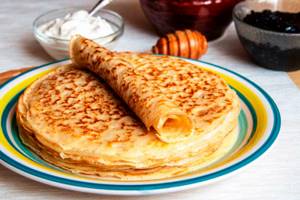
In the article you will learn the main reasons why pancakes tear and stick when turned over and what to do in this situation + a recipe for thin pancakes that never stick to the pan. It would seem that nothing could be easier than making pancakes, because this is not such a complicated dish. It seems that there can be no serious difficulties in preparing them. But some housewives never cease to wonder why pancakes tear and stick when turned over, what to do when such a misfortune happens every time?
It is worth studying the cooking process in more detail in order to understand once and for all what is the secret of whole, crispy, rosy and delicious pancakes and how to fix pancakes sticking to the pan. We also recommend that you look at our website for recipes for pancakes that never tear: with milk, with water, with kefir.
Note to the hostess
- In order for the pancakes to turn out perfect, a personal frying pan must be allocated for them.
- Before pouring the first portion of dough, the oiled frying pan must be heated to a barely noticeable smoke, then removed from the stove for 5-6 seconds. And only after that pour the dough. Bake pancakes over medium heat.
- Don't be upset if the first pancake turns out to be lumpy. Usually it is used to judge how much dough needs to be poured into the pan. If necessary, add more flour or, conversely, make the dough thinner. By the way, you cannot add flour to the entire dough, as it will be difficult to get rid of lumps. You need to pour a little dough into another bowl, mix thoroughly with flour and only then combine with the rest of the dough.
And one last thing. After scraping the stuck pancake from the pan, it is not enough to just wipe it. It needs to be washed well, calcined, and then oiled again. And, most importantly, believe that everything will work out!
Hi all! Maslenitsa is just around the corner, which means the smell of pancakes will soon be wafting through the house. Of course, this does not mean that this should not happen on another day. After all, the Russian people really love these suns in all variations. And with filling and just dipped in sour cream or jam. For breakfast, lunch or dinner. We can eat them in any quantity and at any time!
I don’t know about you, but our family makes it a habit to bake them on weekends. Therefore, before you have time to get out of bed in the morning, the children are already waiting for this wonderful dish for tea.
Any housewife knows that there are simply a huge number of recipes for this dish. After all, pancake dough can be kneaded with sourdough, sourdough and even beer. And if you use yeast, it will turn out no less tasty. But not everyone likes to bake them. Some people simply can’t do it, so they simply don’t make their loved ones happy with this dessert.
Even the most experienced housewife or cook knows that there is a whole set of rules that will help make pancakes perfect. But even knowing them, the first pancake can still come out lumpy. What can you do to prevent this from happening and prevent your pancakes from sticking to the pan? This is exactly what you will learn from our article today.
Changing the pan
This reason is the most common among all. After all, even skillful and experienced housewives experience problems when trying to bake pancakes in a frying pan just bought in a store. If you have new aluminum or cast iron utensils in your kitchen, then carry out a number of manipulations with them.
First of all, place it on the stove, filling the bottom with salt and soda. Moreover, one tablespoon is enough for the latter. Stir the resulting mixture periodically until it changes color to cream. After this, cool the pan and wash thoroughly.
Now you can start baking pancakes and be sure that they will turn out just perfect.
Oil saving
Even if you adhere to a diet and proper nutrition, you should not give up oil when preparing pancakes. Remember that they cannot be tasty without this important ingredient. Therefore, immediately abandon recipes that do not initially say about adding oil. Also keep in mind that even the most modern frying pan needs to be oiled. This affects the taste of the pancakes and their appearance.
If your pancakes do not want to turn over, then add oil to the dough and try to grease the pan with it before each pouring of the dough. In the case of this Russian dish, we can say that it is difficult to spoil it with an abundance of fat.
